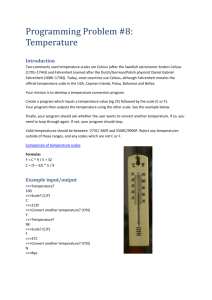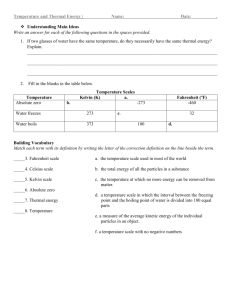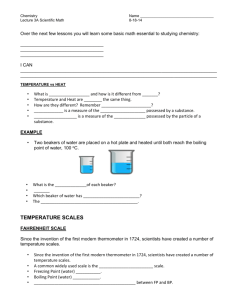Adding And Subtracting Integers
advertisement
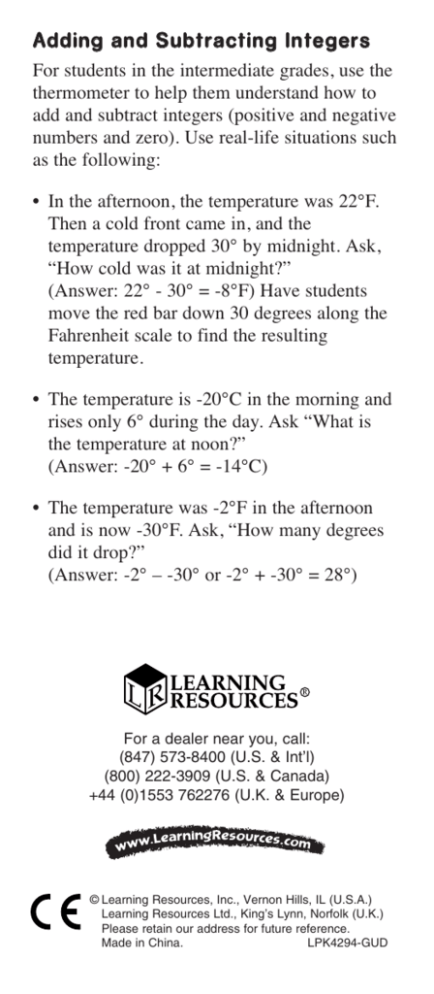
Ad d i ng an d S ub t ra ct i ng In te g er s For students in the intermediate grades, use the thermometer to help them understand how to add and subtract integers (positive and negative numbers and zero). Use real-life situations such as the following: • In the afternoon, the temperature was 22°F. Then a cold front came in, and the temperature dropped 30° by midnight. Ask, “How cold was it at midnight?” (Answer: 22° - 30° = -8°F) Have students move the red bar down 30 degrees along the Fahrenheit scale to find the resulting temperature. • The temperature is -20°C in the morning and rises only 6° during the day. Ask “What is the temperature at noon?” (Answer: -20° + 6° = -14°C) • The temperature was -2°F in the afternoon and is now -30°F. Ask, “How many degrees did it drop?” (Answer: -2° – -30° or -2° + -30° = 28°) For a dealer near you, call: (847) 573-8400 (U.S. & Int’l) (800) 222-3909 (U.S. & Canada) +44 (0)1553 762276 (U.K. & Europe) © Learning Resources, Inc., Vernon Hills, IL (U.S.A.) Learning Resources Ltd., King’s Lynn, Norfolk (U.K.) Please retain our address for future reference. Made in China. LPK4294-GUD LER 4294 OVERHEAD Demonstration Thermometer Teaching Guide Overhead Demonstration Thermometer is a 10" dual-scale transparent model with an adjustable red bar to indicate temperatures. The left side shows the Fahrenheit scale from -40° to 212°; the right side shows the Celsius scale from -40° to 100°. Each scale has marks labeled for every ten degrees, with smaller subdivision marks between them to indicate temperatures to the nearest two degrees. Although there are several types of thermometers, this overhead thermometer represents the liquid-in-glass type, which is the best known. The liquid- in-glass thermometers are used to determine the temperature in or outside a building, to measure body temperature, and for cooking. The adjustable red bar on the overhead thermometer represents the liquid contained in real thermometers. Here’s how it works: The liquid fills a glass bulb connected to a sealed glass tube partially filled with liquid. When the temperature goes up, the volume of the liquid expands and the liquid rises. A temperature scale is on the outside of the thermometer, alongside the glass tube, to indicate the degrees Fahrenheit or degrees Celsius. T alki ng a bo ut T h er m o m et e rs Begin by displaying the thermometer on the overhead projector. Ask, “What are thermometers used for?” (Answer: To measure heat energy, how hot or cold something is.) “Have you ever seen a thermometer that looks like this one? Have you seen or used other kinds of thermometers such as a clinical or fever thermometer for taking a person’s temperature? Were they disposable? Have you ever seen a digital thermometer? Have you ever seen a digital sign on office buildings or banks showing the time and the temperature given in Fahrenheit and Celsius degrees?” R ea d i ng t h e T he r m o me t er Point out the two temperature scales, Fahrenheit and Celsius, on the thermometer, and the highest and lowest number of degrees for each scale. Explain that it looks very much like a ruler with different markings on both scales. You may wish to read aloud each of the tens of degree markings. Point out the zero on both scales. The temperatures above zero on either scale are positive and may be read as “45 degrees Fahrenheit” or as “8 degrees Celsius above zero.” Note that the temperatures below zero have a negative sign to indicate a negative number of degrees, and may be read as “10 degrees Celsius below zero” or “minus 10 degrees Celsius.” Take turns pointing out various positive and negative temperatures and zero on the thermometer, and have students identify them. Next, show them how the adjustable red bar works. Tell them as the temperature rises, the red bar goes up. Similarly, when the temperature gets cooler, the red bar goes down. 2 This red bar, operated by you or a volunteer, represents the liquid contained in the liquid-inglass type of thermometer. Position the red bar at 50°F. Ask, “If I want to know the temperature in degrees Fahrenheit, which scale do I use? What is the temperature shown in degrees Fahrenheit (ºF)?” Keeping the red bar in the same place, now ask students what the temperature is in degrees Celsius (ºC). Because many indoor and outdoor thermometers have a dual scale, students may get confused reading it, just as they do when they are working with a dual-scale ruler. To avoid confusion, conduct the temperature reading exercises by covering up one of the scales with a piece of paper. Have them focus on one scale at a time. A sso ci a t ing Te m p er a tu re s wi t h D ai ly A ct iv it i e s Here are examples of daily activities in which students can use the thermometer. Ask, “Which temperature is most likely for a cup of hot cocoa?” (Answer: 120°F/49°C) “A dish of ice cream?” (Answer: 36°F/2°C) “A good day to go swimming?” (Answer: 92°F/33°C) C onver sions To challenge students, ask them to convert temperatures from one scale to the other. Here are the conversion relationships: • To convert Fahrenheit temperatures to Celsius, subtract 32° and then multiply by 5/9. Use this formula: C = 5/9 (F – 32°). • To convert Celsius temperatures to Fahrenheit, multiply by 9/5 and then add 32°. Use this formula: F = 9/5C + 32°. 3

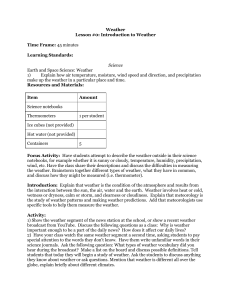

![Temperature Notes [9/22/2015]](http://s3.studylib.net/store/data/006907012_1-3fc2d93efdacd086a05519765259a482-300x300.png)
